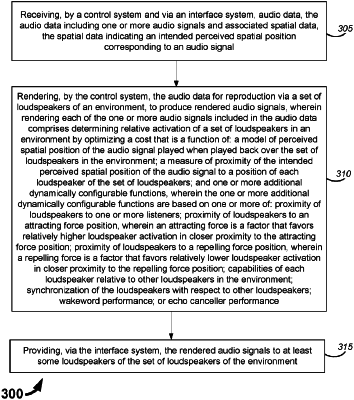| CPC H04R 5/04 (2013.01) [H04R 29/001 (2013.01); H04R 2400/01 (2013.01); H04R 2430/20 (2013.01); H04S 2400/15 (2013.01)] | 17 Claims |

|
1. An audio processing method, comprising:
receiving, by a control system and via an interface system, audio data, the audio data including one or more audio signals and associated spatial data, the spatial data indicating an intended perceived spatial position corresponding to an audio signal;
rendering, by the control system, the audio data for reproduction via a set of loudspeakers of an environment, to produce rendered audio signals, wherein rendering each of the one or more audio signals included in the audio data comprises determining activating gains for each loudspeaker of a set of loudspeakers in an environment by optimizing a cost function that includes the following components:
a model of perceived spatial position of the audio signal played when played back over the set of loudspeakers in the environment;
a measure of proximity of the intended perceived spatial position of the audio signal to a position of each loudspeaker of the set of loudspeakers; and
one or more additional dynamically configurable functions, wherein the one or more additional dynamically configurable functions are based on one or more of: proximity of loudspeakers to one or more listeners; proximity of loudspeakers to an attracting force position, wherein an attracting force is a factor that favors relatively higher activation gains for loudspeakers in closer proximity to the attracting force position; proximity of loudspeakers to a repelling force position, wherein a repelling force is a factor that favors relatively lower activation gains for loudspeakers in closer proximity to the repelling force position; capabilities of each loudspeaker relative to other loudspeakers in the environment;
wakeword performance; or echo canceller performance; and
providing, via the interface system, the rendered audio signals to at least some loudspeakers of the set of loudspeakers of the environment.
|